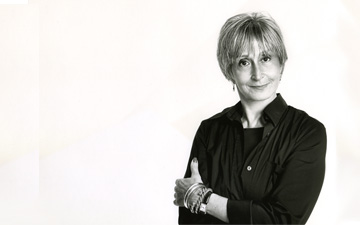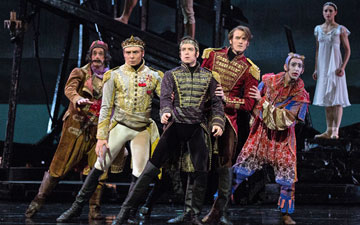
© Gene Schiavone. (Click image for larger version)
American Ballet Theatre
Bach Partita, Gong, The Tempest
New York, David H. Koch Theater
3 November (matinée) and 5 November 2013
www.abt.org
Twyla Tharp’s Bach Partita, or the Magnificence of Form
George Balanchine died in April of 1983 and Twyla Tharp’s Bach Partita premièred in December of that year. Could there be a link there? It is certainly Tharp’s most Balanchinean work, a triumph of clarity and complexity, hierarchy, fluidity of form and technical sophistication. In many ways, it is a summation of the choreographer’s understanding of the classical idiom. American Ballet Theatre’s revival of the work, after a twenty-eight-year absence from the repertory makes a strong case for its return. Susan Jones, the ballet mistress responsible for the staging, spent a year deciphering and notating the choreography from two blurry videos (no-one remembered all the steps, and two of the original dancers are no longer with us). Her diligence has paid off. The ballet looks impeccable, freshly scrubbed. Which is no easy task, since it never stands still.
The ballet, which uses Bach’s monumental second Partita for solo violin as its backbone, sets in motion three principal couples, seven soloist couples, and a corps of sixteen women. Tharp deploys them in constantly-shifting combinations; the stage never looks the same. She begins with two couples, animated by the rather severe, plainspoken allemande. (All the movements of the violin Partita are based on Baroque dance forms, though they don’t always sound like it.) At the Koch, the young violinist Charles Yang stands in the darkened pit, facing the stage, illuminated only by the faint light of his Ipad (on which he followed the score). He plays with grit, intensity, and a rich, full tone (with some amplification). Meanwhile the dancers sway, unfold their legs to the front while tilting back on a bent leg, exchange places, jut their hips, and tip forward with their arms held straight out like airplane wings.
Throughout the ballet, Tharp’s movement is technical, precise and highly articulated. As with Balanchine, the bodies are always distinct, framed in space. The stage never feels crowded, except in the final movement (the chaconne), when an ensemble of women in long jersey dresses streams on and off, adding density and weight to the stage picture. (The principal women wear short leotard dresses and the men wear shorts and neat ribbed t-shirts, all in a rather ugly shade of beige. Costumes are by Santo Loquasto.) The first, second, and fourth movements are each dominated by a single couple, though not exclusively. In fact, it’s not unusual to have three pas de deux going on at once, independent of each other. In these cases the eye is forced to jump from one to the other, and it’s virtually impossible to catch everything. By bringing the dancers forward or back, Tharp creates a layering effect. Things can get even more complicated: at one point in the second movement there are two women, two men, and two couples onstage, all doing different things. Every once in a while, Tharp throws in a moment of unison, as if to cut the audience a break. But it never lasts for long.

© Gene Schiavone. (Click image for larger version)
This magnificent machine whirs on for thirty minutes. Over time, the principal couples reveal individual characteristics: the first duet, danced on Nov. 3 by Polina Semionova and James Whiteside, is lyrical and grand. The second is cheeky and vernacular; Gillian Murphy and Marcelo Gomes danced the roles with flair. (On a strictly technical level, Murphy’s multiple pirouettes are formidable.) The third duo starts out elegantly and then, in the fourth movement (a gigue), launches into a passage of quick-footed virtuosity, full of fast spins, taps, and, for the woman, jumps that land casually in the man’s arms. Stella Abrera and Calvin Royal – the latter looking perfectly at ease despite this being one of his very first principal roles – were particularly stylish, all long lines and bright footwork. Of all the principals, Semionova seemed the least comfortable with Tharp’s complex juxtapositions of steps and quick transitions, meant to highlight the mechanics of the body. But it’s just a question of time until she gets it. In the second cast, which I saw on November 5, Isabella Boylston (in Abrera’s role) danced with a striking combination of fearlessness and chic. Joseph Gorak – a member of the corps with beautiful, pure lines – was another standout. Amid a very strong group of soloists, Christine Shevchenko, Luciana Paris, and Sterling Baca were particularly fine.
As with Balanchine, Tharp’s style in Bach Partita is all about intelligibility. The arms are clean, the feet articulate, the legs strong, the positions clear. But what makes Bach Partita more Tharp than Balanchine, in addition to the odd wiggle, hip bump and head bobble is that clean, all-American feel. There’s no fuss, no old-world courtliness. If anything, the ballet’s only weakness is that it is a little relentless, a little dry. It’s all architecture. Tharp doesn’t really plumb the depths of the music. The effect of the violin Partita, especially the chaconne, is cumulative; it bores deeper and deeper. Tharp doesn’t really go for subtexts, and so the emotional effect remains rather flat, unaccented. Bach Partita is brilliant, but not exhilarating or moving in the way that Balanchine’s Concerto Barocco can be.

© Gene Schiavone. (Click image for larger version)
Another work being performed by the company this week is Mark Morris’s Gong, created in 2001. I caught it at the Nov. 3 matinée. This appealingly quirky piece is set to music by the Canadian composer Colin McPhee that sounds like Balinese-gamelan-by-way-of Hollywood. (The piece is called Tabuh-Tabuhan). In response, Morris has created a charming bit of tongue-in-cheek exotica. The joke is that he treats the ballet vocabulary with as much irony as he does the ersatz Balinese flourishes. The women wear dangling gold earrings; their hair hangs in long braids down their backs. Isaac Mizrahi’s beautiful, jewel-colored costumes (with tutus of different circumferences and textures) are adorable, accessorized with golden belts at the waist and ankles, a reference to the exquisite gilded costumes of Balinese dancers. In one section, Michael Chybowski’s lighting creates shadows against the back wall, evoking shadow puppetry. Ballerinas on pointe tilt over like dolls or walk in plié like apes; dancers hold their palms together at their foreheads, sink into deep pliés with palms outstretched and fingers curled back, or pound out rhythms with their feet. Morris even explores slow motion in two extended pas de deux executed in silence, almost daring the dancers not to make a sound. Dancing in silence is an anomaly for Morris, whose inspiration almost always lies in the music; perhaps he too needed a break from McPhee’s bombastic score. The ballet is full of ideas, all of them clever, but the choreography feels trapped in the coyness of the concept. One can’t help thinking that the dancers never truly get to dance.

© Marty Sohl. (Click image for larger version)
A second cast of Alexei Ratmansky’s new Tempest, with Cory Stearns in the role of Prospero, further underscored the ballet’s weakness, but also its strengths. (My first impressions are here.) The main problem lies in a kind of overall inertness underscored by the ballet’s episodic structure, and made worse by the heavy-handed scenery and costumes (by Santo Loquasto). The energy of the ballet never completely gets off the ground. But there are gems along the way, beginning with the first duet for Prospero and Ariel; as danced by this second cast it becomes even more evident that their relationship is akin to that between a stern father and his rebellious son. Gabe Stone Shayer is a more complex Ariel than Daniil Simkin, more exotic and creaturelike, less self-aware. When Prospero sets him free at the end of the ballet, he nearly explodes with pent-up energy, bending his torso and throwing his head back with sensual abandon. (I wonder how he would be as Petrouchka, or as the Specter of the Rose?) Stearns is a graver, more imposing Prospero than Marcelo Gomes; the memory of his kingly past lingers on his stretched, pointed limbs and weighted movements. James Whiteside is less noble than Herman Cornejo as Caliban; he relishes the twisted, monstrous aspect of the character whereas Cornejo brought out his noble soul. Whiteside’s jumps are wilder, but his final aria of despair is less moving. The fools’ dance (set to Sibelius’s “Humoreske” for woodwinds) for Trinculo and Stephano, all pratfalls and bombastic folk steps, is a delicious set-piece straight out of commedia dell’arte. (If only they would lay off the bit about Caliban’s cloak.) Above all, the dignified, pantomime-like flashback with which Ratmansky describes Prospero’s betrayal by his brother Antonio is a marvel of economy, reminiscent of José Limón’s Moor’s Pavane. It’s a flawed work with moments of great poetry.

















You must be logged in to post a comment.